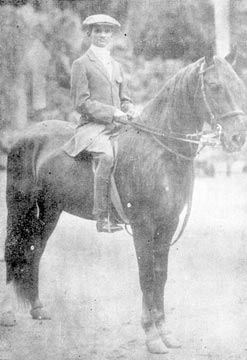|
Musings:
Multimillionaire's son - martyr of Lanka's freedom movement
by Padma Edirisinghe
Why did this young man, Edward Henry Pedris, born in 1889 June,
suddenly spring to the limelight this June with the debut of the book on
him at an assembly held under the aegis of the President of Sri Lanka?
Here is the explanation. He was only 24 when he was shot on the orders
of the then governor, Robert Chalmers, ironically a scholar and ardent
admirer of Buddhism and Pali.
|

Edward Henry Pedris. Pic courtesy: Wikipedia |
But unfortunately he got deeply enmeshed in racial riots that
originated in distant Gampola over an issue of a religious sect opposing
the Wallahagoda temple procession as it meandered its way before a
mosque. No drums will disturb the silence of the place, declared the
mosque officers.
Population
And all hell broke loose in the quiet town that boasted a Sinhala
Buddhist population with a large section come over from South Lanka to
dabble in coffee plantations activities.
In fact a ring leader of the Gampola riots had been one David Silva.
Silva, Pedris - the names in themselves carried remnants of Portuguese
influence and in the case of the young martyr his parents had added on
to his name, Henry and Edward, two English first names. But none of all
this Europeanization could prevent the young lad as he grew up from
observing all what he saw around with disgust. The rebellion that spread
from Gampola to Kandy and then to Colombo that subscribed the final
ammunition was only an excuse for him to exhibit his nationalism. Here
the writer must pause to explain how a mosque matter got bloated into a
national crisis. Chalmers had been misdirected in the matter that the
rebels were against the British rule too and were stoking the fires of
nationalism against the govt.
Anyway even before young Pedris got involved with the rebellion that
spread to the capital too he was highly disgusted with the way the
imperialist faction went about their everyday activities treating the
locals as third class citizens. His scuffles in this area are
reminiscent of Mahathma Gandhi's actions in South Africa against the
governing party. But he was much younger to the great Gandhi.
Incidentally, what was Gandhi doing in South Africa? Few are in the know
that Gandhi was born and bred in an affluent family in India and was
sent for higher studies to England from where he reigned and went over
to indulge in the law profession in South Africa that was suffering from
a dearth of professionals with a knowledge of English.
Education
It was a drama reenacted in many a colony. Many a young Asian and
African came back, almost carbon copies of the rulers, but a few such as
Gandhi and our Bandaranaike revolted. Sorry for that digression, which
however explains matters.
Young Pedris however never went for foreign studies but had his
education at S.Thomas' and Royal, yet he too came from a very affluent
family in Colombo. Perhaps his ancestral family migrated to the capital
to enlarge fortunes. Anyway his father, by the time his son's fatal
tragedy took place had risen to be the number 1 plumabago dealer in
Colombo owning mines in Kalutara and around present Ganagaramaya. He is
also said to have owned about 60 houses in the city from which he drew
high rents.
Henry Edward Pedris as his only son was heir to it all and could have
just basked in luxury but he chose to do otherwise. As town guard he
observed and heard how the native man and woman was humiliated on the
streets and in public conveyances by the Suddhas.
In a certain cinema hall he himself was asked to give over his seat
to an Englshman saying that they were reserved for the Whites but he
refused. Riding on his horse along the capital's narrow streets he,
proud and bold, would neither nor humbly make way for the White men
though they expected it.
Meanwhile, the course of justice following the 1915 rebellion had
gone awry, the faction opposing the Sinhala faction having succeeded to
court the goodwill of the administrators.
The memoirs of Maha Mudaliyar Sir Solomon Dias Bandaranaike of
Horagolla fame reveals how many Sinhala families had to forfeit their
ancestral lands due to unfair jurisdictions. Already young Pedris's mind
was prejudiced when he was ordered to shoot the rebels in the city. A
refusal to do so escalated the already bitter relations leading to the
final execution.
Patriots
It would be unfair here not to relate the names of the many patriots
who got embroiled with this 1915 drama and were imprisoned. These
included famous names such as Sir DB Jayatileka, FR. Senanayake, DS
Senanayake, AE Goonesinghe, Dr. CA Hewavitharana, John de Silva (Lawyer
cum playwright) Piyadasa Sirisena (Novelist). Arthur Dias, Harry Dias,
Ven Sri Subhuthi of Battaramulla (the past 3, social activists).
They had all, some 60 leading Sinhala Buddhists, been imprisoned in
the L wing of Welikada prison, the most degraded section where food had
been just thrown into the cages.
The irony here is that a good segment of them were those living in
luxury.
In the melee of all this, young Pedris who had refused an imperious
order was to be shot, an order given by a governor intoxicated with a
mad frenzy. (He was later recalled). Much exertion was made by the
public to save the young man. These would be saviours included his
school staffs and also Sir Ponnambalam Ramanathan.
As a last resort to save the young man's life still in his Twenties,
the desperate family had promised his weight in gold. But all ruses
failed.
Today he stands a mere statue at an entrance to the city, an emblem
to human folly in one of the most disgraceful stages of human history. |

